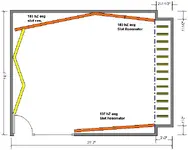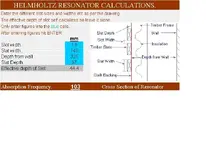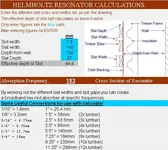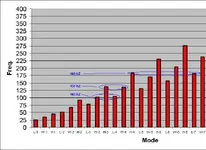S
ScottPetersen
New member
Hello there,
Long time reader, first time poster here. I work as a sound designer for a computer game company. Due to many factors, I finally have a space dedicated to recording my foley/vox work some live instrument recording with a modest (!) 10K budget to spend on materials and labor, some of which I will do myself. We have just recently finished ripping the carpet out of the roughly 17x22x8.5' space (metal stud, drywall/drop down acoustic ceiling tile) and are ready to put the laminate flooring in. Meanwhile, I have been poring over all of my resources and scouring the internet for more information on how to tackle the acoustics of the room. A minor/major factor in my plan is the ability to re-use the majority of acoustic treatment when we inevitably move in three years, once our office space lease is up. The shape of the room lends itself very well to a short wall of acoutic hangar bass traps and then some bass trap paneling angled down the long walls. I may or may not want the panel traps to be full height, the major factor there is access to outlets and network ports. The real problem for me is figuring out how much diffusion to put in and what kind. I really don't quite understand the resonant slat diffusors (yet) so I am loathe to spec them, and I am sure I can do couble duty bass trap/diffusion on most of my panel traps and even on the low bass hangar area, but I just don't really have the feel for what is the right amount.
This is a live only space, any monitoring done here will not be critical.
So, whaddya think of this plan?
Grey=existing walls
Brown=bass hangars
Yellow=diffusion panels
Orange=bass/mid-bass panel traps
Should I treat the 5'4"x7' window?
Should I include hangars behind the angled panel traps?
Should I angle the panel traps at all (or maybe sawtooth them)?
Thanks for lookin,
Scott Petersen
Long time reader, first time poster here. I work as a sound designer for a computer game company. Due to many factors, I finally have a space dedicated to recording my foley/vox work some live instrument recording with a modest (!) 10K budget to spend on materials and labor, some of which I will do myself. We have just recently finished ripping the carpet out of the roughly 17x22x8.5' space (metal stud, drywall/drop down acoustic ceiling tile) and are ready to put the laminate flooring in. Meanwhile, I have been poring over all of my resources and scouring the internet for more information on how to tackle the acoustics of the room. A minor/major factor in my plan is the ability to re-use the majority of acoustic treatment when we inevitably move in three years, once our office space lease is up. The shape of the room lends itself very well to a short wall of acoutic hangar bass traps and then some bass trap paneling angled down the long walls. I may or may not want the panel traps to be full height, the major factor there is access to outlets and network ports. The real problem for me is figuring out how much diffusion to put in and what kind. I really don't quite understand the resonant slat diffusors (yet) so I am loathe to spec them, and I am sure I can do couble duty bass trap/diffusion on most of my panel traps and even on the low bass hangar area, but I just don't really have the feel for what is the right amount.
This is a live only space, any monitoring done here will not be critical.
So, whaddya think of this plan?
Grey=existing walls
Brown=bass hangars
Yellow=diffusion panels
Orange=bass/mid-bass panel traps
Should I treat the 5'4"x7' window?
Should I include hangars behind the angled panel traps?
Should I angle the panel traps at all (or maybe sawtooth them)?
Thanks for lookin,
Scott Petersen

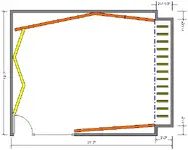
 . That said, the door is solid core and the wall opposite the door/window is a full-height firewall which really does help minimize any flanking noise. I would also like to mention that the acoustic treatment I build might not have to be portable, just transferrable. For example, I could easily re-use the bass hangars in a new room even if I have to cut all of them to a new size to fit the new space.
. That said, the door is solid core and the wall opposite the door/window is a full-height firewall which really does help minimize any flanking noise. I would also like to mention that the acoustic treatment I build might not have to be portable, just transferrable. For example, I could easily re-use the bass hangars in a new room even if I have to cut all of them to a new size to fit the new space. 
